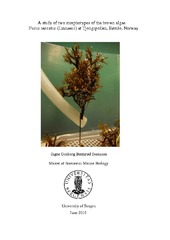| dc.description.abstract | Abstract The genus Fucus contains several key forming species occupying rocky shores in the Northern Hemisphere. Fucus is known to have a great capacity for phenotypic plasticity and ability to expand in to marginal habitats. Assumed recent species radiation within Fucus complicates the process of describing and separating between distinct species. One species in the genus Fucus is Serrated Wrack (Fucus serratus), a canopy forming fucoid occupying the low intertidal in rocky shores. In Bømlo, situated on the west coast of Norway, a landlocked fjord (poll) is inhabited by a small Fucus morphotype that is most likely derived from F. serratus. This small morphotype occupy the zone of F. serratus inside the poll, where F. serratus is observed to have a very restricted distribution. This small morphotype has not yet been thoroughly investigated and many questions exists around its origin, possible adaptations and possible ability to hybridize with F. serratus, which is found in great abundance on the outside of this poll. To investigate these morphotypes this study applied several methods. A common garden experiment was used to see the effect on growth in different salinities and temperatures representing inside and outside poll conditions during late summer/autumn. Morphometric measurements was used to compare morphological characters between morphotypes. Reproductive crossings were conducted in order to test possible reproductive barriers between morphotypes in different salinities. Sequencing of a relatively variable mitochondrial gene, the mitochondrial intergenic spacer (mtIGS), was done to look for genetic differences between the two morphotypes. The common garden experiment did not show significant differences in absolute growth, but some difference in the progression of growth between treatments was found. A surprising result in this experiment was that a substantial number of F. serratus individuals were damaged from bacterial infections, especially in the poll conditions, while the small morphotype was unaffected. Morphometrics clearly separated these morphotypes, and a few characters were found to be more characterizing for the small morphotype, the most obvious being lack of serration, adventitious branching and variation in receptacle shape. Crossing showed a capacity for hybridizing between morphotypes, both in poll and marine conditions. Sequencing of mtIGS revealed one mutation to be common in the small morphotypes, while there was no variation in F. serratus. For future studies a reciprocal transplant and whole genome sequencing is suggested in order to further resolve questions about the adaptations and status of the small Fucus morphotype. | en_US |
